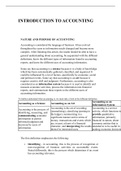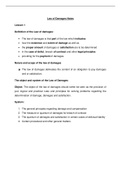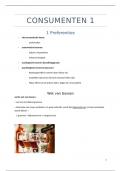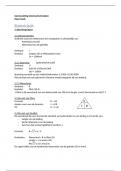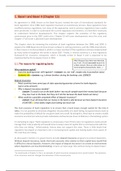Lecture 1 Epidemiological aspects of tumors
Descriptive cancer epidemiology
The risk of developing cancer at a later age is higher in men (45%) than in women (38%).
Changes also increase overtime, but differ by cancer type what the risk is for developing this
in a lifetime.
The cancer diagnosis rises due to the aging population and lifestyle. Epidemiology is
important for the knowledge about trends in incidence and survival/mortality after cancer.
Can be used to develop, implement and evaluate effective policies for cancer control.
Prevalence: number of patients with cancer that are
present at the population at risk at a certain
moment/time.
e.g. 5-year prevalence at 1 January 2019 in the NL: all
living cancer patients who have been diagnosed in the previous 5 years in the NL
Incidence: newly diagnosed cases of cancer
e.g. incidence in 2018 in the NL: number of newly
diagnosed cancer cases in 2018 in the NL
Incidence is expressed in several ways:
- Number: absolute numer of new cases in a certain period
- CR (crude rate): number of new cases per 100,000 persons per year
- ESR (European standardized rate): number of new cases per 100,000 persons per
year, standardized for the age composition of Europe
- WSR (World standardized rate): number of new cases per 100,000 persons per year,
standardized for the age composition of the world
Mortality: number of cases that died from cancer.
e.g. mortality in 2018 in the NL: number of cases that
died from cancer in 2018 in the NL. Also expressed as
number, CR, ESR, WSR (similar to incidence)
Relative survival: cancer cases that are still alive.
The percentage of cancer cases alive at a certain time
period after diagnosis (not including those who died from
other diseases) e.g. 5-year relative survival: Percentage of cancer cases who survived 5
years
1
,Worldwide there are differences in total cancer incidence, but this also differences between
men and women.
Worldwide differences in stomach cancer incidence differs because of helicobacter pylori
and food conservation. Helicobacter is a virus that can cause stomach cancer, more
prevalent in Asian countries.
Worldwide differences in liver cancer incidence differs because of Hepatitis B and Aflatoxin.
More common in Asia and parts of Africa. Aflatoxin, which is a mold that grows on peanuts
and when they aren’t stored dry enough this Aflatoxin can be developed.
Worldwide differences in cervix cancer (baarmoederhals kanker) incidence differs because
of Human Papillomavirus and is more prevalent in Africa.
Most frequent and invasive tumors in the Netherlands
Nowadays there is a better survival of all cancers when looking back. All cancer types have
a different mortality and survival, this is also influenced by the cancer stage.
Etiologic cancer epidemiology (risk factors)
The most important risk factor for cancer in general is age. Time is needed for accumulation
of damage to daughter cells. Mutations in regulatory genes: spontaneous, chemical
substances, radiation and viruses.
Different tools protect people from mutations such as DNA repair, apoptosis and mitosis stop
(senescence).
Cancer at older age
- Accumulation of damage / mutations in regulatory genes
- More damage to repair tools / repair tools less effective
- Less control by micro-environment
Relatively there are more old people, called the gray pressure. People over 65 is increasing
and the cancer diagnosis also rises because of this. The % of patients alive after diagnosis
increases.
Public health problems
- Double aging phenomenon
- Better survival because of early detection and improved treatment
- More expensive health care: diagnosis and treatment
It is important to prevent cancer, instead of cure it.
2
,How do you identify causes of cancer
1. Accidental finding / keep alert
Nuns don’t get children, so they don’t breastfeed. Nuns have less exposure to estrogens, so
hormonal risk factors for developing breast cancer are higher risk.
X-rays were involved in the development of several types of cancer, such as skin cancer.
2. Systematic counting / trends
Retinoblastoma, cancer type in the eye. Some children develop retinoblastoma in one eye
and some in both. They thought with one eye they need 1 hit to develop cancer and with two
eyes you probably already had one mutation and needed another mutation to develop the
retinoblastoma.
People living in Japan have a high risk for developing stomach cancer and as soon as they
move to the United States per generation this risk becomes lower.
3. Focussed research: human observational studies / experimental studies
Design of a case-control study: start with a population and select patients with cancer. Then
you create a comparison group of healthy people. Comparable mostly with respect to age.
Look at if there is a difference between the case and
control group.
There is also a prospective cohort study where we first look at the exposure and then at the
disease.
Examples are smoking, doping.
3
, 4. Exploration
GWAS: people with cancer are compared to healthy controls in their gene expression.
Especially the low penetrance risk alleles are identified, so genetic mutations that are very
common in the population, but don’t have a high relative risk.
Lifestyle-related risk factors for cancer
33% of cancers can be prevented by a healthy diet, body weight, and physical activity. This
evidence needs to be strong. You have convincing and probable evidence, which are the
basis for recommendations.
- Convincing evidence is strong evidence that is unlikely to change in the future and
needs at least 2 independent cohort studies.
- Probable evidence also needs at least 2 independent cohort or 5 case-control studies
and plausible evidence from laboratory studies.
Obesity is involved in the development of different types of cancer, this differs.
Population attributable (preventable) fraction (PAF)
Calculate how much of a certain cancer type could be
prevented by taking away the risk factor.
RR = relative risk of disease for the risk factor
p = prevalence (proportion) of the risk factor in the population
Important to remember that it is dependent on the relative risk and prevalence risk of the
population.
Prevalence of obesity in China for example compared to the US is less, so also see less
cancer incidences.
Cancer can be prevented by increasing physical activity. Also alcohol can be a lifestyle risk
for developing several types of cancer, most common is breast cancer. Also fruit and meat
have an influence on the development of cancer.
Conclusion: don’t smoke, avoid being overweight, be active and eat healthy.
4
Descriptive cancer epidemiology
The risk of developing cancer at a later age is higher in men (45%) than in women (38%).
Changes also increase overtime, but differ by cancer type what the risk is for developing this
in a lifetime.
The cancer diagnosis rises due to the aging population and lifestyle. Epidemiology is
important for the knowledge about trends in incidence and survival/mortality after cancer.
Can be used to develop, implement and evaluate effective policies for cancer control.
Prevalence: number of patients with cancer that are
present at the population at risk at a certain
moment/time.
e.g. 5-year prevalence at 1 January 2019 in the NL: all
living cancer patients who have been diagnosed in the previous 5 years in the NL
Incidence: newly diagnosed cases of cancer
e.g. incidence in 2018 in the NL: number of newly
diagnosed cancer cases in 2018 in the NL
Incidence is expressed in several ways:
- Number: absolute numer of new cases in a certain period
- CR (crude rate): number of new cases per 100,000 persons per year
- ESR (European standardized rate): number of new cases per 100,000 persons per
year, standardized for the age composition of Europe
- WSR (World standardized rate): number of new cases per 100,000 persons per year,
standardized for the age composition of the world
Mortality: number of cases that died from cancer.
e.g. mortality in 2018 in the NL: number of cases that
died from cancer in 2018 in the NL. Also expressed as
number, CR, ESR, WSR (similar to incidence)
Relative survival: cancer cases that are still alive.
The percentage of cancer cases alive at a certain time
period after diagnosis (not including those who died from
other diseases) e.g. 5-year relative survival: Percentage of cancer cases who survived 5
years
1
,Worldwide there are differences in total cancer incidence, but this also differences between
men and women.
Worldwide differences in stomach cancer incidence differs because of helicobacter pylori
and food conservation. Helicobacter is a virus that can cause stomach cancer, more
prevalent in Asian countries.
Worldwide differences in liver cancer incidence differs because of Hepatitis B and Aflatoxin.
More common in Asia and parts of Africa. Aflatoxin, which is a mold that grows on peanuts
and when they aren’t stored dry enough this Aflatoxin can be developed.
Worldwide differences in cervix cancer (baarmoederhals kanker) incidence differs because
of Human Papillomavirus and is more prevalent in Africa.
Most frequent and invasive tumors in the Netherlands
Nowadays there is a better survival of all cancers when looking back. All cancer types have
a different mortality and survival, this is also influenced by the cancer stage.
Etiologic cancer epidemiology (risk factors)
The most important risk factor for cancer in general is age. Time is needed for accumulation
of damage to daughter cells. Mutations in regulatory genes: spontaneous, chemical
substances, radiation and viruses.
Different tools protect people from mutations such as DNA repair, apoptosis and mitosis stop
(senescence).
Cancer at older age
- Accumulation of damage / mutations in regulatory genes
- More damage to repair tools / repair tools less effective
- Less control by micro-environment
Relatively there are more old people, called the gray pressure. People over 65 is increasing
and the cancer diagnosis also rises because of this. The % of patients alive after diagnosis
increases.
Public health problems
- Double aging phenomenon
- Better survival because of early detection and improved treatment
- More expensive health care: diagnosis and treatment
It is important to prevent cancer, instead of cure it.
2
,How do you identify causes of cancer
1. Accidental finding / keep alert
Nuns don’t get children, so they don’t breastfeed. Nuns have less exposure to estrogens, so
hormonal risk factors for developing breast cancer are higher risk.
X-rays were involved in the development of several types of cancer, such as skin cancer.
2. Systematic counting / trends
Retinoblastoma, cancer type in the eye. Some children develop retinoblastoma in one eye
and some in both. They thought with one eye they need 1 hit to develop cancer and with two
eyes you probably already had one mutation and needed another mutation to develop the
retinoblastoma.
People living in Japan have a high risk for developing stomach cancer and as soon as they
move to the United States per generation this risk becomes lower.
3. Focussed research: human observational studies / experimental studies
Design of a case-control study: start with a population and select patients with cancer. Then
you create a comparison group of healthy people. Comparable mostly with respect to age.
Look at if there is a difference between the case and
control group.
There is also a prospective cohort study where we first look at the exposure and then at the
disease.
Examples are smoking, doping.
3
, 4. Exploration
GWAS: people with cancer are compared to healthy controls in their gene expression.
Especially the low penetrance risk alleles are identified, so genetic mutations that are very
common in the population, but don’t have a high relative risk.
Lifestyle-related risk factors for cancer
33% of cancers can be prevented by a healthy diet, body weight, and physical activity. This
evidence needs to be strong. You have convincing and probable evidence, which are the
basis for recommendations.
- Convincing evidence is strong evidence that is unlikely to change in the future and
needs at least 2 independent cohort studies.
- Probable evidence also needs at least 2 independent cohort or 5 case-control studies
and plausible evidence from laboratory studies.
Obesity is involved in the development of different types of cancer, this differs.
Population attributable (preventable) fraction (PAF)
Calculate how much of a certain cancer type could be
prevented by taking away the risk factor.
RR = relative risk of disease for the risk factor
p = prevalence (proportion) of the risk factor in the population
Important to remember that it is dependent on the relative risk and prevalence risk of the
population.
Prevalence of obesity in China for example compared to the US is less, so also see less
cancer incidences.
Cancer can be prevented by increasing physical activity. Also alcohol can be a lifestyle risk
for developing several types of cancer, most common is breast cancer. Also fruit and meat
have an influence on the development of cancer.
Conclusion: don’t smoke, avoid being overweight, be active and eat healthy.
4


